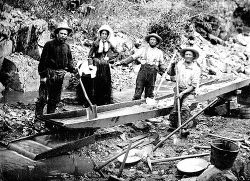Difference between revisions of "Template: Featured article 07 6" - New World Encyclopedia
From New World Encyclopedia
| Line 1: | Line 1: | ||
{{Main page article box| | {{Main page article box| | ||
type=Featured| | type=Featured| | ||
| − | title= | + | title=California Gold Rush| |
| − | image_name= | + | image_name=1850 Woman and Men in California Gold Rush.jpg| |
| − | image_desc= | + | image_desc=Prospectors working California gold placer deposits in 1850| |
| − | text=''' | + | text=The '''California Gold Rush''' (1848–1855) began on January 24, 1848 when [[gold]] was found by [[James W. Marshall]] at [[Sutter's Mill]] in [[Coloma, California]] The news of gold brought approximately 300,000 people to [[California]] from the rest of the United States and abroad. The influx of gold into the money supply reinvigorated the American economy, and the population increase allowed California to go rapidly to statehood. The Gold Rush had a tragic impact on [[Indigenous peoples of California|Native Californians]] and accelerated the [[Native American]] population's decline from disease, starvation and the [[California Genocide]]. |
| − | |||
| − | |||
}} | }} | ||
Revision as of 23:08, 22 June 2020
Featured Article: California Gold Rush
The California Gold Rush (1848–1855) began on January 24, 1848 when gold was found by James W. Marshall at Sutter's Mill in Coloma, California The news of gold brought approximately 300,000 people to California from the rest of the United States and abroad. The influx of gold into the money supply reinvigorated the American economy, and the population increase allowed California to go rapidly to statehood. The Gold Rush had a tragic impact on Native Californians and accelerated the Native American population's decline from disease, starvation and the California Genocide.
